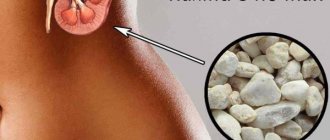With cystic enlargement of the distal part of the ureter, which is accompanied by a bulging bladder, a disease such as ureterocele is diagnosed. In other words, it is a cyst.
This pathology is quite rare, accounting for only 2-3% of all pathologies in urology, and in the female half the defect is three times more common. In most cases, the diagnosis of this disorder occurs in childhood; a concomitant complication may be duplication of the ureters.
Ureterocele occurs on both one and two sides. There are several types of violation:
- Simple. Localized in a healthy ureter. Drop-down. In another way, this type is called prolapsing. In this case, the cyst opens outward through the urethra and appears as a dark, purple-colored formation that is surrounded by mucous membrane with ulcers. In boys, prolapse of this formation occurs in the prostatic urethra, which provokes an immediate retention of urine.
- Ectopic. This type develops in the ureter, which is abnormally positioned and opens into the urethra or anterior vagina. In some episodes, the ureterocele may end blindly. This defect can be congenital or acquired.
With stage 1 congenital cyst, there is a slight expansion of the intravesical section of the ureter, which does not affect normal functioning.
Grade 2 is characterized by an increased size of the formation, which causes ureterohydronephrosis. Grade 3 is also accompanied by ureterohydronephrosis along with dysfunction of the bladder.
Ureterocele of the bladder. Source: prourologia.ru
Etiology, pathogenesis and clinic
A cystic tumor of the distal bladder most often acts as a congenital anomaly that develops against the background of:
- narrowing of the mouth of the ureter, which occurred even at the stage of intrauterine development of the fetus;
- lengthening of the intramural section of this organ;
- lack of muscle fibers in the distal segment of the ureter;
- disruption of the innervation process in the bladder and nearby tissues.
In addition, often abnormalities in the ureter develop against the background of the expectant mother’s addiction to bad habits, drug overdose, radiation and poor nutrition.
Acquired ureterocele in women and men in all situations is a consequence of strangulation of a bladder calculus in the intramural segment of the ureter, i.e. at its mouth.
The pathogenesis of this disease has several characteristics and consists of:
- disruption of the process of urine outflow from the ureter;
- increase in hydrostatic tone;
- overstretching of the wall of the ureter, its bulging into the cavity of the bladder;
- stagnation of urine in the renal pelvis, which is also called hydronephrosis.
The above changes and complete lack of treatment for ureterocele can lead to the development of irreparable complications.
Doctors also identify the following reasons that contribute to the development of ureterocele (ICD-10 code – Q62 – has already been identified earlier):
- congenital features of the development of the ureter;
- pathological elongation of the ureter segment;
- weakness of the muscle fibers of the organ;
- stone formation;
- hydronephrosis;
- disruption of the epithelial layer of the bladder;
- urine outflow disorder;
- impaired mobility of the lower parts of the ureter.
The presence of bad habits in the mother during the period of intrauterine formation of organ rudiments in the child leads to pathology. The initial symptoms of the development of ureterocele of the bladder do not have pronounced manifestations.
With further progression of the disease, symptoms of ureterohydronephrosis appear. A severe degree of the disease is characterized by involuntary urinary incontinence. The clinical picture of the disease is characterized by the appearance of the following symptoms of ureterocele in men:
- Acute pain localized in the lower abdomen and kidneys.
- Difficulty urinating.
- The appearance of symptoms of renal colic. They occur in the urinary tract and are paroxysmal in nature. If this symptom appears, you should immediately go to the hospital for emergency medical care.
- An increase in body temperature to subfebrile is the body’s reaction to the accumulation of urine and the development of inflammation in the urinary organs.
- Pain during urination.
- Hematuria.
- Exacerbation of chronic diseases of the genitourinary system.
- The presence of an unpleasant odor of discharge, intermittent claudication. The latter occurs due to the pathological development of the formation and pinching of large vessels.
- The color of urine and the nature of discharge changes. The patient's urine is dark in color with a persistent unpleasant odor.
It should also be noted that fluid accumulates in the uretocele cavity, which is excreted during urination with secretions such as pus, blood, and mucus. If left untreated, the patient may develop urosepsis, as well as pyelonephritis.
Disease prevention
There are no proven methods for preventing congenital pathology. In order to prevent ureterocele from forming as a result of urolithiasis and other diseases of the genitourinary system, it is necessary to treat them in a timely manner, undergo preventive examinations, and periodically undergo appropriate tests.
Therefore, when you first suspect the presence of this disease, you must immediately consult a specialist.
Causes
The causes of ureterocele include:
- intrauterine disorders in the development of the distal (lower) part of the fetal ureter, accompanied by a lack of muscle fibers of the walls of the bladder and pathological narrowing of the orifice of the ureter;
- the formation of stone deposits in the kidneys and their movement into the ureter, which leads to blockage of the mouth and expansion of the tube.
When the outlet narrows or becomes blocked, the lower part of the ureter expands and its walls inevitably stretch. Cyst-like cavities form and fill with urine.
We suggest you familiarize yourself with: The best drugs to increase potency Levitra
Sometimes their contents may be watery or purulent. Externally they are formed from the mucous membrane of the bladder, and internally from the mucous membrane of the ureter. In the future, these cystic formations can fall into the bladder and even the urethra.
- Ectopic. It is characterized by an opening into the bladder diverticulum or urethra.
- Prolapsing. This is a type in which pathological nodes fall out into the urethra.
- Simple. Cystic formations are located in the cavity of the ureter. Divided into one-sided and two-sided.
The first two types are congenital; in adults, the simple variety is more common. If this anomaly is not treated, serious complications are possible, including kidney failure. Therefore, it is important to start therapy on time.
Doctors still do not have a common opinion about what could be the main reason that contributes to the appearance of ureterocele. However, there is detailed information about exactly what factors can lead to the formation of such a pathology.
So, what can contribute to the development of a ureterocele?
This pathology can be provoked by severe and long-term poisoning with some chemical substances, for example, at work, where you have to breathe harmful fumes of any compounds. The development of such a disease can be greatly influenced by the unfavorable environmental situation in the place of residence, as well as excessive alcohol consumption and nicotine intoxication.
Long-term use of hormonal medications and drugs against tuberculosis increases the risk of ureterocele; in addition, various pathologies that impair the excretion of urine from the body can also pose a danger.
As soon as fluid begins to accumulate in the body, it gradually stagnates and turns into an excellent environment for the proliferation of various pathogenic bacteria, which naturally leads to further formation of pus.
Diagnostics
To suspect a ureterocele, patient complaints about changes in the nature of urination, changes in the color of urine, pain in the lower back, more often with prolonged stay in one position, help. For differential diagnosis, such patients are prescribed general blood and urine tests, a biochemical blood test, urine tests according to Nichiporenko and Zimnitsky, a three-glass urine test, the Roberg test and urine culture for bacterial flora. These methods make it possible to determine both the presence of urinary tract pathology and the level of its location and severity.
The most informative research method for ureterocele is ultrasound of the bladder. Ultrasound examination of the bladder allows you to visualize cystic expansion, assess its size and the risk of complications. It is always combined with an ultrasound of the kidneys to identify and assess the degree of development of hydronephrosis - a complication of ureterocele, in which the renal pelvis expands.
To determine the need for surgical intervention, X-ray urography and cystography are used. Using X-ray methods, they detect defects in the filling of the ureters and bladder, and also help to detect other malformations of the urinary system (doubling kidneys, transformations in the shape of the kidneys, kidney aplasia).
If there are doubts about the diagnosis, endoscopic diagnostic methods can be used - cystoscopy (examination of the bladder from the inside through a probe inserted into the urethra) and laparoscopy (examination of the bladder from the outside using cameras inserted into the abdominal cavity). Such methods are mostly of a therapeutic and diagnostic nature, since right during the examination a decision is made on one or another surgical method of treatment, which is immediately applied.
Symptoms
Such a disease from the urinary system can be completely asymptomatic, up to the development of pyelonephritis (inflammatory damage to the kidney), the clinical signs of which are:
- a sharp increase in temperature indicators;
- change in the shade and transparency of urine - it becomes darker and cloudier;
- pain localized in the lumbar region.
Against the background of such symptoms, the main clinical picture of the disease develops, which is presented:
- spread of pain to the left or right side;
- false urges to visit the toilet to empty the bladder;
- urinary incontinence;
- unpleasant odor coming from urine;
- the presence of pathological impurities in urine;
- increased urge to urinate;
- fever;
- attacks of renal colic;
- complete disruption of the outflow of urine - most often this symptom is observed in females or in children.
Ureterocele
Symptoms
The most common and quite characteristic signs of ureterocele formation that occur in patients are the appearance of characteristic symptoms for this pathology:
- The appearance of acute or aching pain in the kidney area with migration down the abdomen or to the perineum area.
- Limitation of bladder volume, which leads to frequent symptoms of urinary dysfunction; with a total violation of the outflow of urine leads to acute hydronephrosis, with an increase in the volume of the kidneys and attack-like pain in the lower back.
- Increased frequency of urination up to 10-15 times a day, due to the release of urine in small volumes.
- Urine is released in small portions.
- Constant feeling of heaviness in the abdominal area.
- Pain throughout the entire act of urination.
- Constant aching pain in the lower back.
- Lobbed ureteroceles during urination (mainly in women).
- Renal colic, which is manifested by sharp pain in the kidneys and groin, with fever, chills, fatigue, nausea, vomiting, asthenia.
- Temperature increase.
- Constant recurrent urinary tract infections (chronic cystitis, pyelonephritis).
- Pyuria - discharge of pus in the urine.
- Hematuria – discharge of blood in the urine.
Appearance
Due to their occurrence, there are two types of ureteroceles:
- Congenital ureterocele. Pathology occurs due to abnormal development of the ureter. Such defects include dystrophy of muscle fibers in the ureter segment, impaired transmission of nerve impulses in the bladder, stenosis of the ureteric orifice, and lengthening of the intramural section. All this can happen during the intrauterine development of a child. The cause of the congenital anomaly may be diseases that the mother suffered during pregnancy. For example, rubella, herpes and other infectious pathologies. Alcohol abuse, smoking, and uncontrolled use of medications by the expectant mother can also lead to a congenital anomaly in the fetus.
- Acquired ureterocele. The cause is blockage of the ureteral orifice due to stone formation in the kidneys and their movement.
Possible complications
Ureteral ureterocele leads to a large number of complications, but only if the symptoms are ignored and there is a complete lack of therapy. Thus, the most common consequences are:
- hydronephrosis;
- prolapse of the sac-like formation outward - this occurs through the urethra;
- pyelonephritis in acute or chronic form;
- kidney atrophy;
- profuse hemorrhages from the urinary tract;
- hypertension of a vasorenal nature - this means that the pathology is difficult to treat;
- formation of stones in the kidney;
- renal failure;
- cystitis;
- nephrosclerosis.
Prevention
In order to avoid the development of ureterocele in children and newborn infants, it is necessary:
- during pregnancy, give up bad habits, take medications prescribed by a doctor, and also avoid exposure to radiation and undergo regular examinations by an obstetrician-gynecologist;
- provide children with proper and nutritious nutrition;
- engage in early diagnosis and comprehensive treatment of any ailments of the genitourinary system;
- Ensure that children undergo regular examinations by a pediatrician and other pediatric specialists.
We invite you to read: Anatomy of the prostate gland: structure in men and women
To avoid the formation of a pathological sac-like protrusion at the mouth of the ureter in adults, the following preventive recommendations should be followed:
- constantly strengthen the immune system;
- completely give up addictions;
- eat a balanced diet - it is necessary to minimize the consumption of salt, protein foods, and also completely avoid fatty and spicy foods;
- engage in timely treatment of inflammatory lesions of the bladder and prevent the formation of stones - for this you need to undergo a full preventive examination at a medical institution several times a year and take urine tests every few months.
Early diagnosis and comprehensive therapy make it possible for the patient to fully recover. However, reluctance to seek qualified help is fraught not only with complications, but also with death.
The basis for preventing the onset of the development of this disease is regular preventive examinations by specialized specialists. It is also necessary to carry out timely detection and, of course, further treatment of this formation, thanks to which it will be possible to avoid the development of more serious complications that pose a great danger to human health.
The formation of ureterocele in young children can occur as a result of pathological development of the entire genitourinary system. Thanks to the use of modern diagnostic techniques, it becomes possible to begin treatment in the early stages of the disease.
Flow
Pathology of the ureter is not very common, affecting one in five hundred newborns. In 15% of cases the disease is bilateral. Girls get sick three times more often than boys. Upon examination, the fetus is diagnosed with hydronephrosis.
- Grade 1: slight enlargement of the lower ureter, which does not affect the functioning of the upper urinary tract.
- 2nd degree: a significant increase in the intravesical section, in which the outflow of urine from the kidney is disrupted and hydronephrosis occurs.
- 3rd degree: accompanied by hydronephrosis of the kidney and serious disturbances in the functioning of the bladder.
Ureterocele in children is divided into ectopic and simple. Ectopic is characterized by an unusual location of the ureteric orifice. It may be located lower, flowing into neighboring organs. Often the ectopic variety is combined with a double ureter and pelvis.
Paired ureters intertwine and exit from different lobes of the kidney. This type is diagnosed in young children. In simple cases, the ureteral orifice is located normally.
Symptomatic manifestations of the disease depend on the size of the cystic formations and their location. With small sizes, no clinical symptoms are observed. Children often experience discomfort when urinating.
The baby's symptoms include difficulty urinating, pain that does not have a specific location. Palpation reveals hydronephrotic disorders of the kidney. There are cases of prolapse and strangulation of the ureterocele in the genital fissure.
We suggest you read: How to cause an erection in a man?
In older children, aching, dull pain appears, which is localized in the lumbar region on the side where the pathology is present. When a child complains of difficulty urinating and pain, it is worth contacting a pediatric urologist or pediatrician to begin treatment.
According to the degree of progression, ureteroceles are also distinguished. This:
- First degree. In this case, there is a slight expansion of the ureter, functional changes in the kidney are not observed.
- Second degree. Dilatation of the ureter leads to accumulation of urine and the formation of ureterohydronephrosis.
- Third degree. In addition to the accumulation of urine, pathology of the bladder is observed and its functions are disrupted.
Treatment options
There are several ways to treat ureterocele, but the most optimal treatment process is prescribed only by a doctor after determining the size of the cyst and the type of disease. In addition, when drawing up an individual plan, the physician also takes into account whether there are any concomitant diseases.
Treatment with conservative methods is practically not prescribed, since it does not bring the desired effect; with its help, you can only stop the development of this disease or reduce some symptoms, for example, burning.
To obtain the maximum effect, only surgical treatment is prescribed, in which the cyst is removed after dissection of the ureter. In particularly advanced cases, the patient is referred for abdominal surgery, during which a large cyst is removed.
At the earliest stages of the development of such a pathology, a physician can also use cystoscopic obliteration, however, the treatment plan includes not only surgical treatment, but also a special diet that the patient must adhere to for a certain time.
Open operations
Open abdominal operations on the ureters today are performed quite rarely, since abdominal incisions significantly slow down and complicate rehabilitation. In addition, to prevent the sutures from coming apart in the ureter, it is necessary to use an inserted internal catheter, which causes a lot of inconvenience for the woman. In the postoperative period, in order to prevent the development of inflammatory processes, an antibacterial course is recommended. It is important to note that, despite the forms and stages of ureterocele, this pathology has a good prognosis with timely surgical correction.











